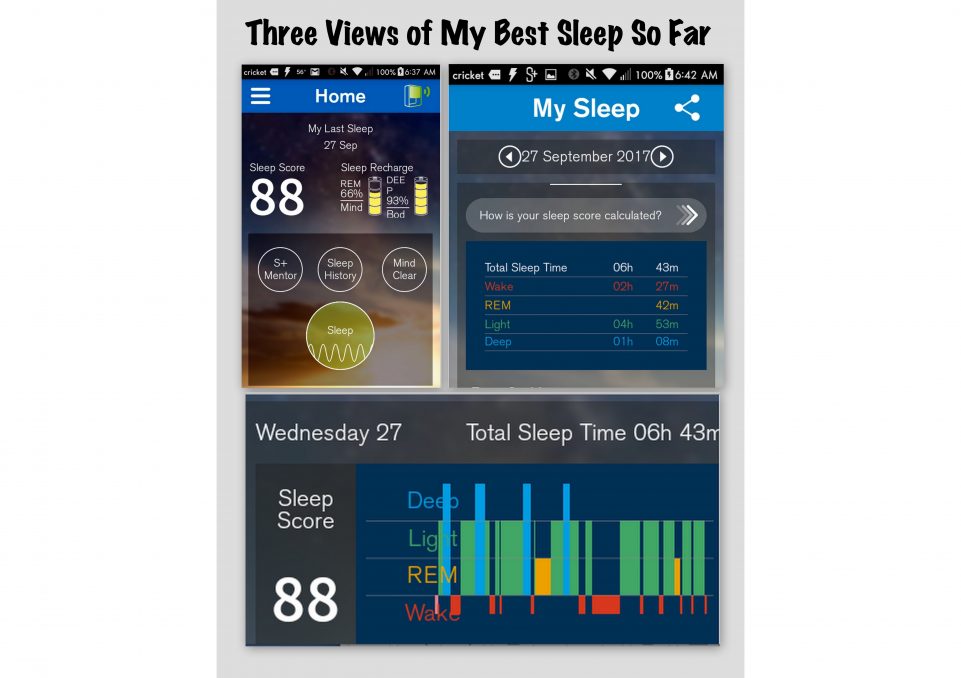I never wanted to go in for a sleep study. The thought of sleeping with electrodes attached to my body sounded so unnatural.
Then a week ago, I was reading my son-in-law’s Popular Science magazine. I came across an ad for a $150 sleep device that would measure all aspects of my sleep without wires.
I learned that the device, the SleepScore Max, would not be available until Oct. 23. But there was still good news. The same company had another device, the S+, and it was half the price of the one in the magazine.
A representative told me on the phone, that the two devices were comparable.
I decided to buy the S+ now, and the SleepScore Max later.
The S+ device gives me a Sleep Score based on the four stages of my sleep: sleep onset*, light, deep, and REM (rapid eye movement) sleep. It also detects when my sleep is interrupted, showing me when I am awake in bed, and when I leave the bed.
The device detects the expansion and relaxation of my chest as I breathe by utilizing ultra low power radio waves at 10.5 GHz. Clothing and blankets do not affect the radio wave transmissions.
The system is similar to the echolocation system used by bats. It uses algorithms that recognize the combinations of my movements.
The device also records the light, noise, and temperature in the room. It syncs to my Smartphone and provides me with a variety of graphs to show the amount and quality of my sleep, and compares my sleep with an ideal sleep for my age and gender.
The device can also wake me up with a Smart Alarm, which will wake me only from a light sleep, close to the time I wish to be awoken.
Here are my six nights of Sleep Scores**, and related information:
9-26-17: Sleep Score = 64 Total Sleep 4h 46m REM 25m, Light 3h 52m, Deep 28m, Wake 3h 44m
9-27-17: Sleep Score = 88 Total Sleep 6h 43m REM 42m, Light 4h 53m, Deep 1h 8m, Wake 2h 27m
9-28-17: Sleep Score = 76 Total Sleep 5h 26m REM 30m, Light 3h, 15m, Deep 1h 41m, Wake 3h 13m
9-29-17: (away)
9-30-17: Sleep Score = 73 Total Sleep 5h 13m REM 47m, Light 3h. 49m, Deep 36m, Wake 3h 30m
10-1-17: Sleep Score = 57 Total Sleep 4h 31m REM 14m, Light 4h. 2m, Deep 14m, Wake 3h 9m
10-2-17: Sleep Score = 83 Total Sleep 6h 21m REM 1h 27m, Light 4h 25m, Deep 28m, Wake 3h 34m
*Sleep Onset is not charted because I have no problem falling sleep
**A Sleep Score below 75 = below average; 50-60 poor sleep; 30-50 very poor sleep
I am not concerned that my sleep scores during the first week have been erratic.
I feel confident that I will improve my sleep in time. Based on a suggestion about light from the S+ app, I have ordered blackout shades for my bedroom window.
I expect to sleep better when light does not enter my bedroom in the morning. And, since I am spending so much time awake in bed, I will follow the app’s suggestion that if, after 20 minutes, I am not sleeping, I get out of bed, and only return when I think I can sleep again.
The S+ is giving me confidence that I can improve my sleep. I made a chart showing all possible sleep data. I will compute weekly and monthly averages, and attempt to further analyze my sleep.
Even though 5½ hours of sleep may be average for my age, my nightly goal is a Sleep Score in the 80’s, with more than six hours sleep. A 2014, one-million-user study by Jawbone, the Fitness Tracker, found that Americans, on average, got that amount of sleep each night.
I expect to let you know if my sleep has improved after October’s data has been recorded. Sweet dreams.
Mr. Ebsen may be contacted at robertzebsen@gmail.com

